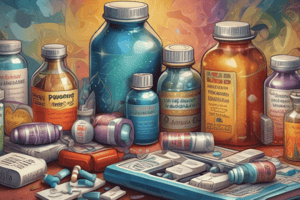Podcast
Questions and Answers
Warum ist das Gefriertrocknen gegenüber anderen Methoden vorteilhaft?
Warum ist das Gefriertrocknen gegenüber anderen Methoden vorteilhaft?
- Es führt zu schnellerem Trocknen als Vakuumtrocknung.
- Es erfordert keine spezialisierte Ausrüstung.
- Es ist kostengünstiger als andere Trocknungsmethoden.
- Es produziert stabile und sterile Dosierungsformen. (correct)
Was ist ein potenzielles Risiko bei der Vakuumtrocknung?
Was ist ein potenzielles Risiko bei der Vakuumtrocknung?
- Geringe Anforderungen an die Ausrüstung im Vergleich zu anderen Methoden.
- Kontamination aufgrund des direkten Kontakts zwischen Oberfläche und Saugeinheit. (correct)
- Geringe Wirksamkeit bei thermolabilen Medikamenten.
- Langsamer Trocknungsprozess im Vergleich zur Lufttrocknung.
Was kann zu mikrobiellem Wachstum und chemischem Abbau in pharmazeutischen Produkten führen?
Was kann zu mikrobiellem Wachstum und chemischem Abbau in pharmazeutischen Produkten führen?
- Hoher Luftdruck
- Starke Lichteinstrahlung
- Kälte
- Hohe Luftfeuchtigkeit (correct)
Was spielt eine entscheidende Rolle in Bezug auf die Stabilität von Arzneimitteln?
Was spielt eine entscheidende Rolle in Bezug auf die Stabilität von Arzneimitteln?
Welche Faktoren beeinflussen die Auswahl einer Trocknungsmethode für ein pharmazeutisches Produkt?
Welche Faktoren beeinflussen die Auswahl einer Trocknungsmethode für ein pharmazeutisches Produkt?
Welche Methode eignet sich am besten für thermolabile Medikamente mit minimaler Wärmeexposition?
Welche Methode eignet sich am besten für thermolabile Medikamente mit minimaler Wärmeexposition?
Was sind die Vorteile des Sprühtrocknens in der Pharmaindustrie?
Was sind die Vorteile des Sprühtrocknens in der Pharmaindustrie?
Welches Problem kann beim Sprühtrocknungsverfahren auftreten?
Welches Problem kann beim Sprühtrocknungsverfahren auftreten?
Was ist ein wesentlicher Vorteil des Gefriertrocknens gegenüber anderen Trocknungsmethoden?
Was ist ein wesentlicher Vorteil des Gefriertrocknens gegenüber anderen Trocknungsmethoden?
Warum ist die Entfernung von Wasser ohne Auftauen wichtig beim Gefriertrocknungsverfahren?
Warum ist die Entfernung von Wasser ohne Auftauen wichtig beim Gefriertrocknungsverfahren?
Was sind typische Herausforderungen bei der Verwendung von Sprühtrocknung in der Pharmaindustrie?
Was sind typische Herausforderungen bei der Verwendung von Sprühtrocknung in der Pharmaindustrie?
Welches Verfahren wird verwendet, um Wasser aus einer gefrorenen Lösung zu entfernen, ohne sie auftauen zu lassen?
Welches Verfahren wird verwendet, um Wasser aus einer gefrorenen Lösung zu entfernen, ohne sie auftauen zu lassen?
Flashcards are hidden until you start studying
Study Notes
Pharmaceutical Product Drying
Pharmaceutical products undergo various processes before reaching consumers, including drying techniques designed to ensure the stability of these compounds while maintaining their quality. This process is essential since it affects the final product's performance, safety, and cost-effectiveness. There are several methods used to dry pharmaceutical products, each with its advantages and disadvantages. These methods include spray drying, freeze-drying, and vacuum drying.
Spray Drying
Spray drying involves atomizing a liquid mixture into small droplets using high pressure or temperature followed by evaporation of the solvent in hot gas flow. This technique is widely used because it provides fast drying times, high yield rates, and low energy consumption. However, the resulting particles may have poor flowability and compressibility due to the process's high shear stress. Spray dried powder may also contain residual solvents, which can impact the product's safety profile. Despite these challenges, spray drying remains a popular choice in pharmaceuticals due to its speed and efficiency.
Freeze-Drying
Freeze-drying, or lyophilization, works by freezing the solution containing the active ingredient, which is then subjected to a vacuum to remove water from the frozen state without thawing. This method preserves the original structure and biological activity of heat-labile drug molecules that cannot tolerate high processing temperatures. One significant advantage of freeze-drying over other methods is its ability to produce stable and sterile dosage forms. However, the process is time-consuming and requires specialized equipment.
Vacuum Drying
Vacuum drying utilizes reduced atmospheric pressure to increase the boiling point of water below room temperature, allowing faster removal of dissolved gases and organic solvents. This method is suitable for thermolabile drugs that need minimal exposure to elevated temperatures during processing. Although it offers faster drying times compared to conventional air-drying, vacuum drying has limitations such as the requirement for expensive equipment and the potential contamination risk due to the direct contact between the material surface and the suction pump.
Moisture Content and Shelf Life Stability
Moisture content plays a crucial role in the stability of pharmaceutical products, affecting both appearance and effectiveness. High moisture levels can lead to microbial growth, chemical degradation, or changes in physical properties like hardness, disintegration, or tablet compactability. Therefore, controlling moisture content through appropriate drying and storage conditions is critical for ensuring the product's stability and extending its shelf life.
In conclusion, the selection of a drying method depends on factors such as product characteristics, required particle size distribution, and desired biological activity retention. Each method has its advantages and disadvantages, so proper consideration must be given when choosing the most suitable technique for a specific pharmaceutical compound.
Studying That Suits You
Use AI to generate personalized quizzes and flashcards to suit your learning preferences.




